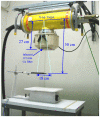Physico-chemical evaluation of rationally designed melanins as novel nature-inspired radioprotectors
- PMID: 19789711
- PMCID: PMC2749938
- DOI: 10.1371/journal.pone.0007229
Physico-chemical evaluation of rationally designed melanins as novel nature-inspired radioprotectors
Abstract
Background: Melanin, a high-molecular weight pigment that is ubiquitous in nature, protects melanized microorganisms against high doses of ionizing radiation. However, the physics of melanin interaction with ionizing radiation is unknown.
Methodology/principal findings: We rationally designed melanins from either 5-S-cysteinyl-DOPA, L-cysteine/L-DOPA, or L-DOPA with diverse structures as shown by elemental analysis and HPLC. Sulfur-containing melanins had higher predicted attenuation coefficients than non-sulfur-containing melanins. All synthetic melanins displayed strong electron paramagnetic resonance (2.14.10(18), 7.09.10(18), and 9.05.10(17) spins/g, respectively), with sulfur-containing melanins demonstrating more complex spectra and higher numbers of stable free radicals. There was no change in the quality or quantity of the stable free radicals after high-dose (30,000 cGy), high-energy ((137)Cs, 661.6 keV) irradiation, indicating a high degree of radical stability as well as a robust resistance to the ionizing effects of gamma irradiation. The rationally designed melanins protected mammalian cells against ionizing radiation of different energies.
Conclusions/significance: We propose that due to melanin's numerous aromatic oligomers containing multiple pi-electron system, a generated Compton recoil electron gradually loses energy while passing through the pigment, until its energy is sufficiently low that it can be trapped by stable free radicals present in the pigment. Controlled dissipation of high-energy recoil electrons by melanin prevents secondary ionizations and the generation of damaging free radical species.
Conflict of interest statement
Figures





Similar articles
-
Protection of melanized Cryptococcus neoformans from lethal dose gamma irradiation involves changes in melanin's chemical structure and paramagnetism.PLoS One. 2011;6(9):e25092. doi: 10.1371/journal.pone.0025092. Epub 2011 Sep 22. PLoS One. 2011. PMID: 21966422 Free PMC article.
-
Synthesis and assembly of fungal melanin.Appl Microbiol Biotechnol. 2012 Feb;93(3):931-40. doi: 10.1007/s00253-011-3777-2. Epub 2011 Dec 16. Appl Microbiol Biotechnol. 2012. PMID: 22173481 Free PMC article. Review.
-
The radioprotective properties of fungal melanin are a function of its chemical composition, stable radical presence and spatial arrangement.Pigment Cell Melanoma Res. 2008 Apr;21(2):192-9. doi: 10.1111/j.1755-148X.2007.00430.x. Pigment Cell Melanoma Res. 2008. PMID: 18426412
-
Ionizing radiation changes the electronic properties of melanin and enhances the growth of melanized fungi.PLoS One. 2007 May 23;2(5):e457. doi: 10.1371/journal.pone.0000457. PLoS One. 2007. PMID: 17520016 Free PMC article.
-
Biosynthesis of fungal melanins and their importance for human pathogenic fungi.Fungal Genet Biol. 2003 Mar;38(2):143-58. doi: 10.1016/s1087-1845(02)00526-1. Fungal Genet Biol. 2003. PMID: 12620252 Review.
Cited by
-
From Extraction to Advanced Analytical Methods: The Challenges of Melanin Analysis.Int J Mol Sci. 2019 Aug 13;20(16):3943. doi: 10.3390/ijms20163943. Int J Mol Sci. 2019. PMID: 31412656 Free PMC article. Review.
-
Protection of melanized Cryptococcus neoformans from lethal dose gamma irradiation involves changes in melanin's chemical structure and paramagnetism.PLoS One. 2011;6(9):e25092. doi: 10.1371/journal.pone.0025092. Epub 2011 Sep 22. PLoS One. 2011. PMID: 21966422 Free PMC article.
-
Radioimmunotherapy of Cryptococcus neoformans spares bystander mammalian cells.Future Microbiol. 2013 Sep;8(9):1081-9. doi: 10.2217/fmb.13.79. Future Microbiol. 2013. PMID: 24020737 Free PMC article.
-
Synthesis and assembly of fungal melanin.Appl Microbiol Biotechnol. 2012 Feb;93(3):931-40. doi: 10.1007/s00253-011-3777-2. Epub 2011 Dec 16. Appl Microbiol Biotechnol. 2012. PMID: 22173481 Free PMC article. Review.
-
Production of Fungal Pigments: Molecular Processes and Their Applications.J Fungi (Basel). 2022 Dec 28;9(1):44. doi: 10.3390/jof9010044. J Fungi (Basel). 2022. PMID: 36675865 Free PMC article. Review.
References
-
- Hill HZ. The function of melanin or six blind people examine an elephant. Bioessays. 1992;14:49–56. - PubMed
-
- Nosanchuk JD, Casadevall A. The contribution of melanin to microbial pathogenesis. Cell Microbiol. 2003;5:203–223. - PubMed
-
- Mirchink TG, Kashkina GB, Abaturov IuD. Resistance of fungi with different pigments to radiation. Mikrobiologiia. 1972;41:83–86. - PubMed
Publication types
MeSH terms
Substances
Grants and funding
LinkOut - more resources
Full Text Sources
Other Literature Sources
Research Materials
Miscellaneous

